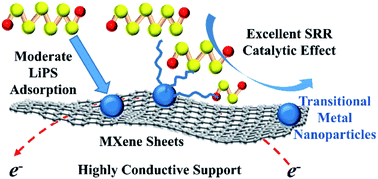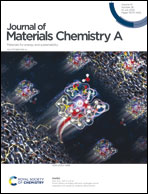MXene supported transition metal nanoparticles accelerate sulfur reduction reaction kinetics†
Abstract
Although tremendous efforts have been made to prevent the dissolution of lithium polysulfide (LiPS) intermediates in Li–S batteries, the sluggish sulfur reduction reaction (SRR) is still less addressed. Here, we develop a class of MXene-supported transition metal nanoparticle (TMNPs@MXene) composites as highly efficient SRR catalysts for Li–S batteries. The MXene support with high conductivity and high affinity to LiPS can effectively activate TMNP catalysts. TMNPs homogeneously dispersed on MXene sheets are the catalytically active sites for the SRR. Among all TMNPs@MXene composites, the CoNPs@MXene composite exhibits the highest SRR electrocatalytic activity, as confirmed by the fast Li+ diffusion, high Li2S deposition capacity, large electron transfer number, and low activation energy. Consequently, the CoNPs@MXene/S cathode-based Li–S cell exhibits higher capacity and rate capability without obvious capacity decay. Theoretical calculations reveal the moderate LiPS adsorption strength and the low Gibbs energy barrier of the rate-limiting Li2S2/Li2S conversion, which account for the excellent SRR activity of the CoNPs@MXene composite. This novel SRR catalyst provides an opportunity for fabricating long-life and high-energy Li–S batteries.



 Please wait while we load your content...
Please wait while we load your content...